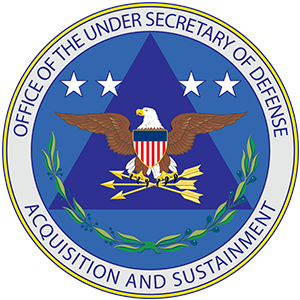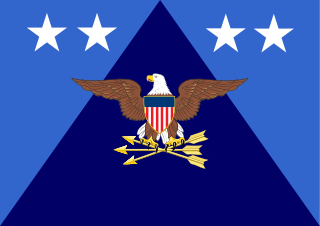
The Defense Information Systems Agency (DISA), known as the Defense Communications Agency (DCA) until 1991, is a United States Department of Defense (DoD) combat support agency composed of military, federal civilians, and contractors. DISA provides information technology (IT) and communications support to the President, Vice President, Secretary of Defense, the military services, the combatant commands, and any individual or system contributing to the defense of the United States.

The National Geospatial-Intelligence Agency (NGA) is a combat support agency within the United States Department of Defense whose primary mission is collecting, analyzing, and distributing geospatial intelligence (GEOINT) in support of national security. Initially known as the National Imagery and Mapping Agency (NIMA) from 1996 to 2003, it is one of the "big five" members of the United States Intelligence Community.

The United States Naval Criminal Investigative Service (NCIS) is the primary law enforcement agency of the U.S. Department of the Navy. Its primary function is to investigate criminal activities involving the U.S. Navy and U.S. Marine Corps, though its broad mandate includes national security, counterintelligence, counter-terrorism, cyber warfare, and the protection of U.S. naval assets worldwide. NCIS is the successor organization to the former Naval Investigative Service (NIS), which was established by the Office of Naval Intelligence after the Second World War.

United States Joint Forces Command (USJFCOM) was a Unified Combatant Command of the United States Department of Defense. USJFCOM was a functional command that provided specific services to the military. The last commander was Army Gen. Ray Odierno. As directed by the President to identify opportunities to cut costs and rebalance priorities, Defense Secretary Robert Gates recommended that USJFCOM be disestablished and its essential functions reassigned to other unified combatant commands. Formal disestablishment occurred on 4 August 2011.

Washington Headquarters Services (WHS) is a Department of Defense (DoD) Field Activity, created on October 1, 1977, to provide administrative and management support to multiple DoD components and military departments in the National Capital Region and beyond.

NetOps is defined as the operational framework consisting of three essential tasks, Situational Awareness (SA), and Command & Control (C2) that the Commander (CDR) of US Strategic Command (USSTRATCOM), in coordination with DoD and Global NetOps Community, employs to operate, manage and defend the Global Information Grid (GIG) to ensure information superiority for the United States.
Joint Task Force-Global Network Operations (JTF-GNO) was a subordinate command of United States Strategic Command whose mission was to: direct the operation and defense of the Global Information Grid (GIG) across strategic, operational, and tactical boundaries in support of the US Department of Defense's full spectrum of war fighting, intelligence, and business operations.

The United States under secretary of defense for policy (USDP) is a high level civilian official in the United States Department of Defense. The under secretary of defense for policy is the principal staff assistant and adviser to both the secretary of defense and the deputy secretary of defense for all matters concerning the formation of national security and defense policy.
Counterintelligence Field Activity (CIFA) was a United States Department of Defense (DoD) agency whose size and budget were classified. The CIFA was created by a directive from the Secretary of Defense, then Donald Rumsfeld, on February 19, 2002. On August 8, 2008, it was announced that CIFA would be shut down. The Defense Intelligence Agency (DIA) absorbed most of the components and authorities of the CIFA into the Defense Counterintelligence and Human Intelligence Center which was later consolidated into the Defense Clandestine Service.
The Assistant Secretary of Defense for Networks & Information Integration was an appointed position that provided management and oversight of all DoD information technology, including national security systems. The ASD(NII) also served as the chief information officer (CIO) of the United States Department of Defense (DoD), a position distinct from the ASD and governed by the Clinger-Cohen Act.
The Information Technology Management Reform Act of 1996 is a United States federal law, designed to improve the way the federal government acquires, uses and disposes information technology (IT). It was passed as Division E of the National Defense Authorization Act for Fiscal Year 1996. Together with the Federal Acquisition Reform Act of 1996, it is known as the Clinger–Cohen Act.

The under secretary of defense for intelligence & security or USD(I&S) is a high-ranking civilian position in the Office of the Secretary of Defense (OSD) within the U.S. Department of Defense that acts as the principal civilian advisor and deputy to the secretary of defense and deputy secretary of defense on matters relating to military intelligence & security. The under secretary is appointed as a civilian by the president and confirmed by the Senate to serve at the pleasure of the president.
The Defense Integrated Military Human Resources System was an enterprise program of the Business Transformation Agency's Defense Business Systems Acquisition Executive, within the United States Department of Defense (DoD). As the largest enterprise resource planning program ever implemented for human resources, DIMHRS was to subsume or replace over 90 legacy systems. The first phase of DIMHRS was expected to roll out first to the U.S. Army in 2009 and bring all payroll and personnel functions for the Army into one integrated web-based system. The U.S. Air Force, United States Navy and the Marines were expected to roll out in that order after the Army had implemented it. On January 16, 2009, the Deputy Secretary of Defense issued a memorandum directing the MILDEPS and the Defense Finance Accounting Service (DFAS), to confirm the "core" enterprise requirements of the capability at that time. Once, confirmed, the BTA was to transition the solution to the individual MILDEPS to build out and deploy their own required personnel and pay solutions using the "core" to the maximum extent possible..(Memorandum, Deputy Secretary of Defense, January 16, 2009, Subject: Acquisition Decision Memorandum for the Defense Integrated Military Human Resources System). The solution was transitioned to the MILDEPS on September 30, 2009. After numerous delays, technical problems, and other issues, in February 2010, the DoD completed the transition of the program, after 11 years and $850 million.

The Under Secretary of Defense for Acquisition and Sustainment, or USD(A&S), is the Principal Staff Assistant (PSA) and advisor to the Secretary of Defense for all matters relating to acquisition and sustainment in the Department of Defense. This includes the DoD Acquisition System; system design and development; production; logistics and distribution; installation maintenance, management, and resilience; military construction; procurement of goods and services; material readiness; maintenance; environment and energy resilience ; utilities; business management modernization; International Armaments Cooperation, Cooperative Acquisition and International Agreements, Promoting exportability of military components to allies and partners; nuclear, chemical and biological defense programs; and nuclear command, control, and communications.

The under secretary of defense (comptroller)/chief financial officer, abbreviated USD(C)/CFO, is a high level civilian official in the United States Department of Defense. The Under Secretary of Defense (Comptroller) is the principal staff assistant and adviser to both the Secretary of Defense and the Deputy Secretary of Defense for all budgetary and fiscal matters, including the development and execution of the Defense Department's annual budget.

Dennis E. Wisnosky is an American consultant, writer and former chief architect and chief technical officer of the US DoD Business Mission Area (BMA) within the Office of Business Transformation. He is known as one of the creators and initiators of the Integrated Definition (IDEFs) language, a standard for modeling and analysis in management and business improvement efforts.

Elizabeth Ann Hight is a retired United States Navy rear admiral who served as the vice director of the Defense Information Systems Agency (DISA). She assumed this post in December 2007. In 2008, she was nominated for appointment to the grade of vice admiral and assignment as director, Defense Information Systems Agency; commander, Joint Task Force – Global Network Operations; and deputy commander, U.S. Strategic Command Global Network Operations and Defense, Arlington, Virginia. Her nomination was rejected by the Senate due to a perceived conflict of interest with her husband, retired Air Force Brigadier General Gary Salisbury, who is vice president of business development and sales for Northrop Grumman Corp.'s mission systems sector, defense mission systems division. She retired from the Navy in 2010.

The United States Army Information Technology Agency (ITA) is one of the administrative service organizations aligned under the Office of the Administrative Assistant to the Secretary of the Army (OAA). OAA has three fundamental functions. The primary mission of the organization is to provide direct support to the Secretary of the Army and other Army political appointees. The second mission is to provide administrative support to the Headquarters, Department of the Army (HQDA). The third mission is to provide base operations support to a diverse group of Army and Department of Defense (DoD) customers. OAA is organized into four major divisions: the U.S. Army Resources and Programs Agency (RPA), the U.S. Army Headquarters Services (AHS), the U.S. Army Information Technology Agency (ITA), and the U.S. Army Center of Military History (CMH). These divisions support OAA primarily in areas of IT, logistics, training, and human resources support.

The chief management officer (CMO) of the United States Department of Defense (DoD) was the third-in-command of the department after the Secretary of Defense and Deputy Secretary of Defense. The position's purpose was to reduce costs by improving the quality and productivity of DoD's business operations. Congress disestablished the CMO position with the passage of the William M. (Mac) Thornberry National Defense Authorization Act for Fiscal Year 2021 effective 1 January 2021.















